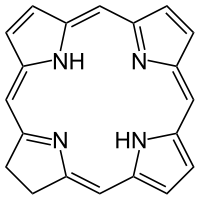- Chlorin
-
Not to be confused with chlorine.
Chlorin 
Identifiers CAS number 2683-84-3 
PubChem 65106 ChemSpider 58616 
ChEBI CHEBI:36303 
Jmol-3D images Image 1 - n3c4cc5nc(cc\1nc(/C=C/1)cc2ccc(n2)cc3CC4)cc5
- InChI=1S/C20H16N4/c1-2-14-10-16-5-6-18(23-16)12-20-8-7-19(24-20)11-17-4-3-15(22-17)9-13(1)21-14/h1-6,9-12,22-23H,7-8H2/b13-9-,14-10-,15-9-,16-10-,17-11-,18-12-,19-11-,20-12-

Key: UGADAJMDJZPKQX-CEVVSZFKSA-N
InChI=1/C20H16N4/c1-2-14-10-16-5-6-18(23-16)12-20-8-7-19(24-20)11-17-4-3-15(22-17)9-13(1)21-14/h1-6,9-12,22-23H,7-8H2/b13-9-,14-10-,15-9-,16-10-,17-11-,18-12-,19-11-,20-12-
Key: UGADAJMDJZPKQX-CEVVSZFKBJ
Properties Molecular formula C20H16N4 Molar mass 312.36784  (verify) (what is:
(verify) (what is:  /
/ ?)
?)
Except where noted otherwise, data are given for materials in their standard state (at 25 °C, 100 kPa)Infobox references In organic chemistry, a chlorin is a large heterocyclic aromatic ring consisting, at the core, of three pyrroles and one pyrroline coupled through four methine linkages. Unlike porphin, the central aromatic ring structure of porphyrins, a chlorin is therefore largely aromatic but not aromatic through the entire circumference of the ring.
Magnesium-containing chlorins are called chlorophylls, and are the central photosensitive pigment in chloroplasts.
 Structures comparing porphin, chlorin, and bacteriochlorin
Structures comparing porphin, chlorin, and bacteriochlorin
Related compounds, with two reduced pyrroles, are called bacteriochlorins and isobacteriochlorins.
Because of their photosensitivity, chlorins are in active use as photosensitizing agents in experimental photodynamic therapy.
Chlorin is not to be confused with the chemical element chlorine.
See also
Types of tetrapyrroles Bilanes
(Linear)PhytobilinsPhytochromobilinPhycobilinsMacrocycle PhytoporphyrinsReduced
porphyrinsPorphyrinogensChlorinsIsobacteriochlorinsSiroheme · SirohydrochlorinCorphinsbiochemical families: prot · nucl · carb (glpr, alco, glys) · lipd (fata/i, phld, strd, gllp, eico) · amac/i · ncbs/i · ttpy/i Categories:- Biomolecules
- Metabolism
- Photosynthesis
- Tetrapyrroles
Wikimedia Foundation. 2010.
